Greetings from Palmia Observatory
Well our road trip to Texas and New Mexico is over and after getting back we got to thinking about how we first got involved with a big interest in SpaceX and what was happening in Boca Chica.
Although we typically describe SpaceX operations at Boca Chica, we are left with not understanding where the original little community, Boca Chica Village, was actually located. I've driven down Texas Highway 4 many time now and had never really found Boca Chica Village. Now we have an aerial view, provided by RGV Aerial Photography, which seems to show maybe all that is left of Boca Chica, or maybe all there originally was.
In this photograph we have Highway 4 at the top of the image and the left hand turnoff at the left side of the image is the last turnoff before you continue your drive and arrive at the SpaceX launch site and then on to the end of the highway at Boca Chica Beach.
But if you take that first left hand turnoff you can see that within just a short distance you come to what looks like a residential area sort of within and surrounded by all the SpaceX facilities. So, we are left wondering if this group of maybe a dozen homes is all that is left of Boca Chica Village?
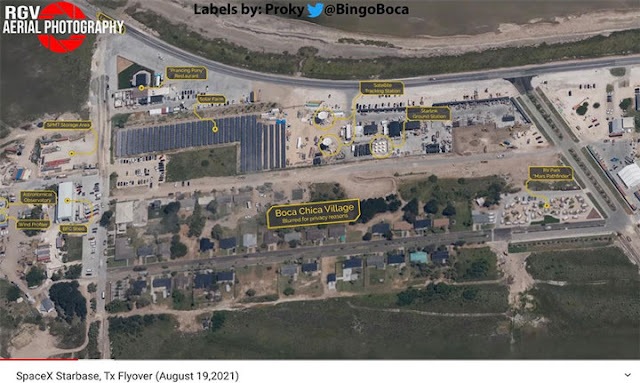 |
| Aerial image showing Boca Chica Village (Source: @RGV Aerial Photography) |
RGV Aerial Photography makes a weekly pass over the area in a rented Cessna 172 and photographs what is happening below. Thanks for keeping us up to date with goings on there!
 |
| Aerial image showing RGV flying over Boca Chica (Source: @RGV Aerial Photography) |
My own interest in Boca Chica goes back to a rudimentary following of the Starhopper project, which SpaceX used as the first prototype that would lead to the Starship project. Check out this Teslarati tweet from August 2019 timeframe.
 |
| An early description of the flight status of Starhopper in August 2019 (Source: @Teslarati) |
A review of earlier blog postings shows that my first glimpse of the desire to get down to Boca Chica and observe for myself what was going there is covered in the October 1, 2019 . After seeing descriptions of activity over a period of several months led to an actual visit as described in blog post of March 16, 2020, followed up by a second visit of August 5, 2021.
Now there are so many online followers of activity at Boca Chica that it is less necessary to go down there to see what is going on. It is easy to follow @BocaChicaGal, and many others, without physically going down there ourselves. But, you miss all of the traffic and construction noise and the grand vistas of all of the construction activity and the size and enormity of the Launch Tower, etc., that it is still very satisfying to be there in person. I don't know when we will get back there, but get back there we surely will, particularly if we can schedule a visit during the launch of the first sub-orbital Starship.
In other news, now that we are still under increased COVID risk, this article in August 21 issue of New Scientist, showing estimates of indoor ventilation compared to outdoors. This has always been of concern to me ever since the pandemic started full force back in February 2020.
This study provides some basic data from which to look into the risk involved with different indoor environments. The study uses the CO2 concentration as a proxy for indoor air quality. You can see right away that indoor air quality has something like twice the amount of CO2 in restaurants as compared to outdoors and some indoor activities like riding in a car with the windows up can be something like four times higher.
Now CO2 is a proxy for virus particles but we have to be careful because not everyone is shedding virus particles, while everyone is shedding CO2 molecules. There is the separate concern that for the individual who is shedding, the air quality is mostly constrained around that person because the virus particles are shed predominately in droplets that mostly fall out of circulation quickly due to gravity.
Anyway this data can also help us evaluate the effectiveness of using masks while indoors. I have found several papers describing this effectiveness which we will review sometime in the future. In the meantime, we can just say that using masks indoors can be effective in some sense, even though we can't quantify it for now. \
For me, the use of masks indoors is currently just a recognition that those individuals who are not vaccinated will take advantage of any recommendation saying that the vaccinated do not need to wear masks indoors, and will just flout the recommendation and go without a mask too. So, the mandate for indoor masks for everyone seems really to be just a recognition of this fact and does not really mean that vaccinated people will face the same risk indoors. The sad result of have indoor mask requirements is that those individuals who are not vaccinated and now given a "pass" to just continue their unvaccinated journey because they aren't faced with any individual concern and everyone else inside has to wear a mask. Sad because the government mandate does nothing to change their behavior.
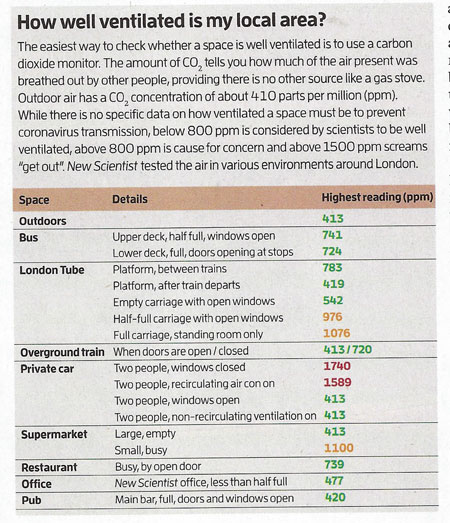 |
| Comparison of how well air ventilation measurements (Source: New Scientist, 21 Aug 2021) |
Finally, let's return to topics for all the physicist wannabes out there. Here are two slides from recent online presentations. The first one shows the shorthand version of the mathematical formulation of the Standard Model of Particle Physics. Hmm, ok, I get that the equation is an action term which sums up all the three fundamental forces of nature: Electromagnetics, Weak Force and Strong Force. I can see where the electromagnetic stress tensor enters into the equation, but can't yet see which of the remaining terms are concerned with the weak force and the strong force. The only other thing I remember for sure is that the term "h.c." means you have to also remember to include and write down all of the "Hermitian Complex" terms corresponding to those already present. Whew, now if I can just get the rest of the terms down! What do you make of the terms in the equation?
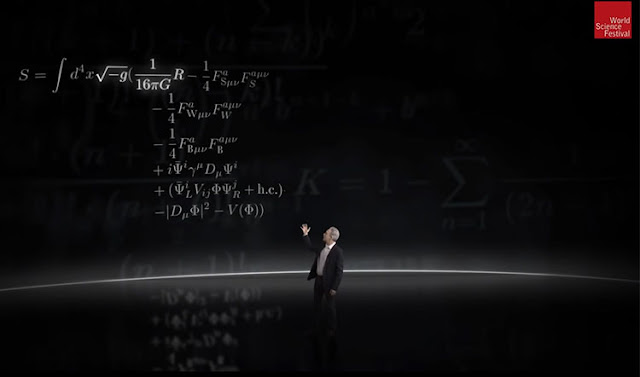 |
| Brian Greene introduces the short hand view of the Standard Model (Source: Brian Greene, WSF) |
And now, the second screen slide for all you armchair cosmologists, here is Brian introducing the Borde-Guth-Vilenkin (BGV) Theorem. I don't understand how the theorem is proved or justified but we see right away that the expansion of the universe introduces some additional concerns that don't show up in laboratory physics where experiments can be performed in steady state conditions. As an armchair cosmologies I see the need for digging into this topic further. Thanks for that Bria!
 |
| Brian discusses cosmological limits on infinite history (Source: Brian Keating, "Into the Impossible") |
In other news, we sat in on the Tesla AI (Artificial Intelligence) Day and got the latest on the continuing development of automobile autopilots for fully self driving (FSD) cars. The description about how the autopilots use neural nets and advanced machine learning algorithms and training was fantastic. One of the key points for me was how Tesla is able to integrate the 8 vehicle cameras into one coherent picture of where the automobile is located. Tesla recognized that the output of all 8 cameras had to be integrated into some coherent vector space prior to identifying any traffic features like roads, lines, parked cars, moving cars, traffic lights, post office boxes at the road edge, etc., was a necessary approach rather than trying to first of all analyze all 8 camera images separately. In this slide from the presentation you can see examples of some of the camera images and how once an integrated vector space is generated then some pattern recognition from that space can be fed back and superimposed on the camera images.
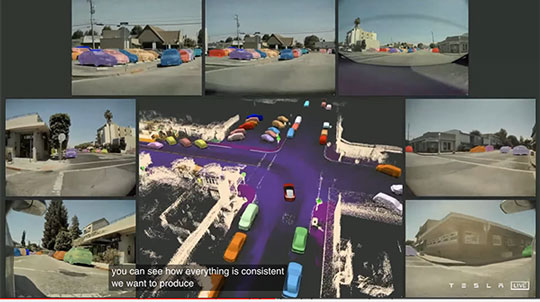 |
| Approach to making consistent vector space representation of the environment (Source: Tesla AI Day) |
Then when the autopilot has a consistent view of its environment, it can then update the automobile driving commands to meet the goals of the driver which might be to get to some destination or even just find a parking spot.
The technical details of the computer system needed for the autopilot include the fantastic rate of floating point operations per second (FLOPS) was really impressive. The amount of information processed gets up into the giga and terra operations per second. Training the neural nets is also an impressive task and requires a gigantic data center to carry out the training. Some slides in the presentation indicated that large data centers, consuming megawatts of electrical power are needed to train the autopilot neural networks. Check out the YouTube video for all the details.
But, another interesting revelation of the day had to do with the recognition that the compute power needed to power a self driving car can be extended to making a fully autonomous robot. Just think you could ask your robot to do chores for you, like go down to the store and replenish your liquor cabinet!
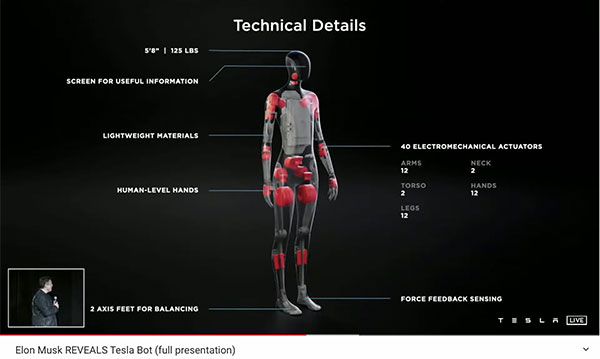 |
| Making a Tesla Bot from the capabilities developed for the autopilot (Source: Tesla AI Day) |
Ok, that is some really impressive predictions coming out of Tesla. I find that Elon is so imaginative and so productive that he can lead such disparate companies like SpaceX and Tesla and be so successful. Some of these features are still years away, but Elon is a driving force for innovation. Go Elon!
Finally, after we missed out on photographing the full Blue Moon, due to pesky clouds, it seemed that we could at least try to capture the near full moon, just a day or two after being full, as it rose above the horizon. Well, in this attempt, I couldn't make out where the moon was, and by the time I saw it creeping above the horizon, it was already 4 degrees above the horizon. We can see in this iPhone photo below that the Moon is maybe already 1-2 degrees above the background hills. Darn! I had hoped to capture the moon with some distant tree or building or transmission line tower directly in front of it, but it was not to happen this time.
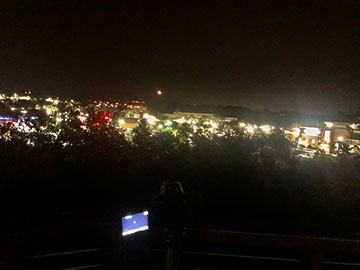 |
| Trying to capture the near full moon rising above horizon (Source: Palmia Observatory) |
When I finally got my act together and set up the camera on its flimsy tripod, I snapped the shutter for this shot. It is a bit out of focus, but here is the 300mm DSLR image. Darn, it seems we have to wait another month for a chance to capture the full moon just coming up above the horizon.
 |
| Misfocused post full moon near horizon, DSLR, 300mm, 1/15 second (Source: Palmia Observatory) |
Until next time,

No comments:
Post a Comment